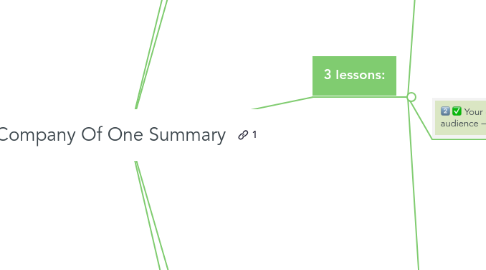
1. 1-Sentence-Summary:
1.1. Company Of One will teach you how going small, not big when creating your own company will bring you independence, income, and lots of free time without the hassles of having to manage employees, long meetings, and forced growth.
2. Favorite quote from the author:
2.1. "Business success does not lie in growing something quickly and massively, but rather in building something that's both remarkable and resilient over the long term." - Paul Jarvis
3. 3 lessons:
3.1. To have a successful company of one, don’t continually aim higher, set profit limits.
3.1.1. The word “more” is the best way to describe the mindset around the modern-day business.
3.1.1.1. Consumers want to buy more.
3.1.1.2. Companies want to sell more.
3.1.2. Buyers are slowly discovering the benefits of saying no to this “never satisfied” mentality
3.1.2.1. Companies can also find success in setting limits on their earnings.
3.1.3. The traditional model of running a personal business is focused on endless growth and, thus, marked with endless stress and overwhelm for the owner.
3.1.3.1. That’s why there’s a whole industry built around books like The E-Myth to help alleviate founder burnout.
3.1.4. But what if, instead of spending your life working for the business, you were able to make the business work for you?
3.1.4.1. This is mostly a matter of intentionally restricting growth to fit within predetermined constraints.
3.1.5. Psychotactics, a company of one run by Sean D’Souza, is the perfect example of deliberately capping profits.
3.1.5.1. D’Souza is a consultant who set his growth limit to $500,000 per year.
3.1.5.1.1. This check is what keeps his company from requiring more employees and time.
3.1.5.1.2. So, instead of spending his time with those, D’Souza gets to play with his kids and go on long vacations.
3.1.5.2. $500,000 is probably enough for you too, isn’t it?
3.2. Your goal should be to reach a specific audience – the more niche, the better.
3.2.1. When Starbucks began in 1971 in Seattle, Washington, their aim was to be the neighborhood boutique coffee place.
3.2.1.1. Unfortunately, as Starbucks’ popularity grew in the early 2000s, the chain lost sight of this original goal and tried to be everything to everyone.
3.2.1.2. The subsequent downturn resulted in the closure of around 900 stores.
3.2.1.3. They came back from this setback by returning to their original vision.
3.2.1.4. If you do the same in your business from the beginning, you may never have to redeem yourself as they did.
3.2.2. If you try to reach everyone in every possible way, you will spread yourself too thin.
3.2.2.1. Also, making your product generic to appeal to a broad audience will – counterintuitively – decrease interest in what you are selling.
3.2.3. The more you can niche down, the better you will be able to help a specific group of people get exactly what they want and need.
3.2.3.1. Put yourself in your client’s shoes.
3.2.3.1.1. Would you rather have a consultant who sort of knows how to do everything or one who knows and uses the exact same platform you use?
3.3. Forget investing big upfront, focus on making a small profit fast instead.
3.3.1. Once your clientele and earnings expand, you may be tempted to quit your day job and begin making large investments both time- and money-wise.
3.3.1.1. Don’t act so fast though.
3.3.1.1.1. Your new little seedling company needs time to expand slowly.
3.3.1.1.2. This way, you can properly manage it and adjust to organic growth.
3.3.2. Going big on investments early in your business might seem like a good idea, but is completely unnecessary.
3.3.2.1. Modern technologies like the internet enable you to earn profits quickly, which should be your first goal as a company of one.
3.3.3. If your startup were to be funded by venture capital instead, you’d be a slave to their requests.
3.3.3.1. Rejecting massive upfront funding grants you more independence.
3.3.4. However, don’t get stuck trying to make a profit forever.
3.3.4.1. The longer you take to make your first income, the more revenue you will need to break even and start making a profit.
3.3.5. Remember that done is better than perfect and just get your first product out.
3.3.5.1. Focus on initial profits so you and your business can move forward.
